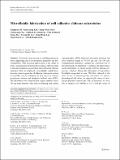Microfluidic fabrication of cell adhesive chitosan microtubes
Author(s)
Lee, Sang-Hoon; Lee, Kwang Ho; Lee, Dong Hwan; Oh, Jonghyun; Kim, Keekyoung; Won, Sung Wook; Selimovic, Seila; Bae, Hojae; Cha, Chaenyung; Gaharwar, Akhilesh; Khademhosseini, Ali; ... Show more Show less
Download10544_2013_Article_9746.pdf (444.2Kb)
PUBLISHER_POLICY
Publisher Policy
Article is made available in accordance with the publisher's policy and may be subject to US copyright law. Please refer to the publisher's site for terms of use.
Terms of use
Metadata
Show full item recordAbstract
Chitosan has been used as a scaffolding material in tissue engineering due to its mechanical properties and biocompatibility. With increased appreciation of the effect of micro- and nanoscale environments on cellular behavior, there is increased emphasis on generating microfabricated chitosan structures. Here we employed a microfluidic coaxial flow-focusing system to generate cell adhesive chitosan microtubes of controlled sizes by modifying the flow rates of a chitosan pre-polymer solution and phosphate buffered saline (PBS). The microtubes were extruded from a glass capillary with a 300 μm inner diameter. After ionic crosslinking with sodium tripolyphosphate (TPP), fabricated microtubes had inner and outer diameter ranges of 70–150 μm and 120–185 μm. Computational simulation validated the controlled size of microtubes and cell attachment. To enhance cell adhesiveness on the microtubes, we mixed gelatin with the chitosan pre-polymer solution. During the fabrication of microtubes, fibroblasts suspended in core PBS flow adhered to the inner surface of chitosan-gelatin microtubes. To achieve physiological pH values, we adjusted pH values of chiotsan pre-polymer solution and TPP. In particular, we were able to improve cell viability to 92 % with pH values of 5.8 and 7.4 for chitosan and TPP solution respectively. Cell culturing for three days showed that the addition of the gelatin enhanced cell spreading and proliferation inside the chitosan-gelatin microtubes. The microfluidic fabrication method for ionically crosslinked chitosan microtubes at physiological pH can be compatible with a variety of cells and used as a versatile platform for microengineered tissue engineering.
Date issued
2013-01Department
Harvard University--MIT Division of Health Sciences and Technology; Koch Institute for Integrative Cancer Research at MITJournal
Biomedical Microdevices
Publisher
Springer US
Citation
Oh, Jonghyun et al. “Microfluidic Fabrication of Cell Adhesive Chitosan Microtubes.” Biomedical Microdevices 15.3 (2013): 465–472.
Version: Author's final manuscript
ISSN
1387-2176
1572-8781